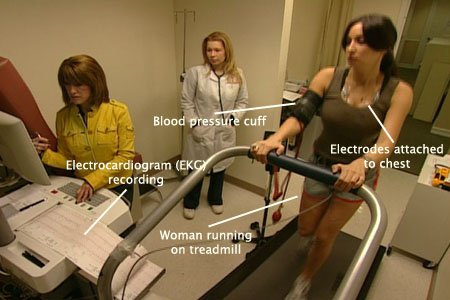What is an exercise stress test?
An exercise stress test measures your heart’s ability to function when it is working hard (or stressed), such as when you exercise. Some heart disease symptoms are not apparent at rest and only show up when the heart is working harder and beating faster than normal. During exercise, your heart needs more oxygen, so your heart has to pump more blood. When your heart is “starved” for oxygen, it produces symptoms such as shortness of breath or chest pain.
The standard exercise stress test uses an ECG to measure your heart’s electrical activity at rest and during exercise, although this test is less accurate in women than in men.1 Exercise testing can also be combined with imaging tests, such as an echocardiogram (stress echo) or nuclear ventriculogram, to produce detailed pictures of your heart under stress. People who are unable to exercise can have a stress test using chemicals that mimic the effect of exercise on the heart.
Cenforce for sale at best online pharmacy
How does an exercise stress test work?
Before you start exercising, the nurse or technician will determine your target heart rate (the number of beats per minute you are aiming for to be sure your heart is working hard) based on your age, height, and weight. A blood pressure cuff will be placed around your arm, and you will be fitted with sticky electrodes attached to an ECG to monitor your heart’s electrical activity. For the standard test, a baseline ECG will be taken. You will then begin to exercise on a treadmill or a stationary bike; the speed and elevation will gradually increase. When you have reached your target heart rate or when you ask to stop because of fatigue or symptoms, this portion of the test will end.

When an exercise stress test is used in combination with an echocardiogram or nuclear ventriculogram, images are taken before and immediately after the exercise portion (while your heart rate is still high). If the imaging test requires contrast dye, you may be injected with it while you are exercising so that it has time to spread through your heart before the images are captured.
Who might have an exercise stress test?
Your doctor may order an exercise ECG alone or combined with an imaging test. Some people have no symptoms of heart failure when they are resting, so an exercise stress test is done to trigger your symptoms and monitor what is happening to the heart when they occur.
Who should not have an exercise stress test?
If you are unable to perform physical activities due to older age, arthritis, excess weight, or other health problems, you may undergo a pharmacological stress test instead, in which you are injected with a chemical as a substitute for exercise.
If you are pregnant or breastfeeding, you should not have any kind of radiation procedure, including a stress nuclear ventriculogram.
How do I prepare for an exercise stress test?
You should not smoke, eat, or drink anything other than water for 2 to 4 hours before an exercise stress test. Tell your doctor about any medications or dietary supplements you are taking because these may affect the accuracy of the test; you may have to stop taking or reduce the dosage of certain medications before the test. You may be unable to resume taking some medications until the tracer is cleared from your body (about 24 hours). If you have diabetes, talk to your doctor about whether you will need to stop taking any diabetes medications the day of the test, and what steps you should take to make sure your blood sugar stays under control if this is the case.
You should wear comfortable, loose clothing and shoes appropriate for exercising. Do not apply lotions or cream on your chest.
What do the results of the exercise stress test mean?
Exercise Stress ECG – As with a resting ECG, your doctor will study the graph paper with the wavy lines recorded by the exercise ECG and check for any irregularity in the pattern, such as a spike or dip in a wave where there shouldn’t be any. Often the exercise test will show signs of a problem even when a resting test was normal. Abnormal exercise ECG results can show heart rhythm problems or signs that the heart is not getting enough oxygen, possibly a result of coronary artery disease.
Stress Echocardiogram – If your stress echocardiogram shows your heart muscle moving less during stress (exercise) than it did at rest, this indicates that your heart is not getting enough blood and oxygen to cope with your increased heart rate, which may mean the arteries supplying blood to your heart are narrowed by coronary artery disease. The doctor will also look for changes in the amount of blood pumped out (ejection fraction) of the ventricles and whether the heart muscle wall is moving properly.
Nuclear Stress Ventriculogram – A nuclear stress ventriculogram allows doctors to see the size of the heart’s pumping chambers and if they are working properly, and to measure the amount of blood pumped out of the ventricles at peak exercise. As with other exercise tests, this imaging test is done under stress. Comparing it with the same test done at rest can provide early clues regarding the strength of your heart muscle.
What are the limitations of an exercise stress test?
The exercise stress ECG is not as accurate at diagnosing heart disease in women as in men, and has a tendency to produce false-positives in women (the test results indicate a heart problem when there isn’t one).2 However, it is generally accurate in ruling out heart problems (such as coronary artery disease).
The stress echocardiogram test is highly accurate in both women and men, but is less accurate in women who are obese or have large breasts because the sound waves have trouble penetrating fatty tissue, producing fuzzy images that are difficult to interpret. Breast implants can also interfere with the test.3
The stress nuclear ventriculogram is also less accurate in women who are obese or have large breasts, but this test is less affected by these problems than most other tests.
What are the risks of an exercise stress test?
Although generally safe, some people who may feel dizzy, short of breath, or excessively tired because of the exercise required for the test. It is also possible that the stress placed on your heart during the test could cause a heart attack (if you already have a severe blockage) or other cardiac problems, but you will be closely monitored during the test and the test will be suspended if there is any sign of a problem.
If the exercise stress test is combined with a nuclear ventriculogram, you will be exposed to a small amount of radiation, although the amount used during the test is considered safe and the technicians are trained to minimize your radiation exposure. For more information on radiation safety, see the National Institutes of Health’s Radiation Fact Sheet.
References
- Morise AP, Diamond GA. Comparison of the sensitivity and specificity of exercise electrocardiography in biased and unbiased populations of men and women. Am Heart J. Oct 1995;130(4):741-747.
- Shaw LJ, Bairey Merz CN, Pepine CJ, et al. Insights From the NHLBI-Sponsored Women’s Ischemia Syndrome Evaluation (WISE) Study: Part I: Gender Differences in Traditional and Novel Risk Factors, Symptom Evaluation, and Gender-Optimized Diagnostic Strategies. J Am Coll Cardiol. February 7, 2006 2006;47(3_Suppl_S):S4-20.
- Movahed MR. Interference of breast implants with echocardiographic image acquisition and interpretation. Cardiovasc Ultrasound. 2007;5:9.





